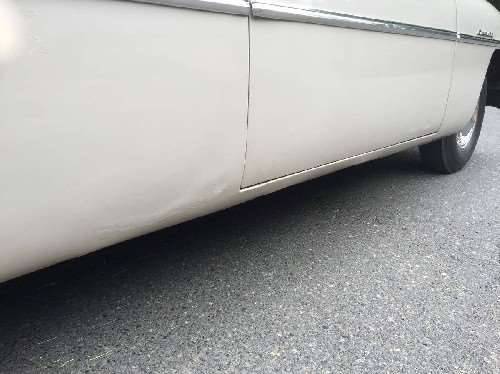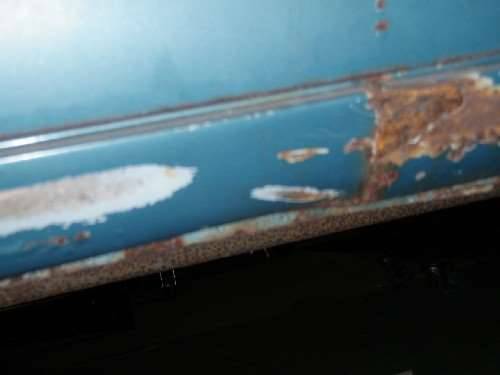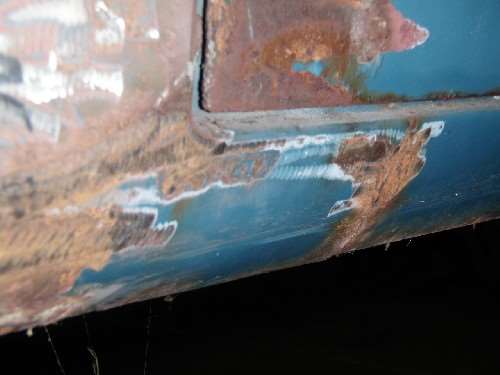|
Re: What's your opinion?
|
||||
|---|---|---|---|---|
|
Forum Ambassador
|
Packard had some real sag and fit issues with the large convertible and coupe doors -- particularly the early 22nd doors. The first production runs had to be field strengthened by tack welding the hinges to the door. After that repair was sent out they notified dealers they were going to bigger bolts and heavier threaded door plates. Not sure if they went to a stronger hinge but IIRC, there was another bulletin after that about using some shims and drilling the door side of hinge to "lock" the position to the door. Don't know if they ever got the sag totally under control.
Perhaps the car still had issues and someone tried to fix it again but either unsuccessfully or didn't spend the time to do a thorough job. I believe the 51 body section has a procedure for bending the door flanges or twisting the door to make them fit more flush with the fender and rockers.
Posted on: 2017/2/3 10:23
|
|||
|
Howard
|
||||
|
||||
|
Re: What's your opinion?
|
||||
|---|---|---|---|---|
|
Home away from home
|
Maybe it's not apparent without zooming, as I did, but about 3-4" up(toward front) from the radius there's a seam from the quarter panel overlap. That was what I was referring too. My doors are quite robust and do not sag. This overlap pushes the quarter out a tad and leaves a large door gap at the bottom. I'll take some close up pictures. I see it on some and not others, so some were fixed, just don't know which ones. Seam correct or not?
Posted on: 2017/2/5 9:20
|
|||
|
||||
|
Re: What's your opinion?
|
||||
|---|---|---|---|---|
|
Home away from home
|
I'm favoring it's the factory fit. Both vehicles are 23 series '49 clubs and have panel overlap. I don't see any interior seams to suggest a repair or patch panel on mine. The whole quarter would have had to be changed, if not original, and unlikely on both sides.
The one side fits about where you'd expect with an overlap fit, about a sheet metal thickness out, but the other side is in the 1/4" range sticking out. Could be the one side stamping or jig was off more. I guess they never heard of trimming or a step die. Packard also used a large number of small spot welds instead of the larger ones I'm used to. Makes panel separation more difficult. Spot weld cutters are useless. You can see the overlap joint line on both sides. You have to zoom in on the other car picture to see it. The 4 drs don't seem to be so afflicted, but not sure. There's a 7K orig 4dr for sale but I can't get a good view from it's pictures. I apologize to all the purists for speaking ill of the Packard or their designee body work methods...
Posted on: 2017/2/5 13:07
|
|||
|
||||
|
Re: What's your opinion?
|
||||
|---|---|---|---|---|
|
Forum Ambassador
|
It is really hard to say what they contended with when making mass bodies in those days. Unlike the modern robot plants where things are assembled to a gnats eyebrow, back then it was probably throw a couple of panels onto some kind of fixture and hope they landed or could be adjusted within reason before the welding started. There is a video of some assy line where guys are throwing panels on a moving apparatus and stepping back just in time so giant machines on either side and just inches away from them could slide in. Could easily see a panel that slightly missed the mark would wind up being off..
My 47 has a discrepancy too but on the drivers side rear door. It has the floor panel and bottom of door opening welded at an angle so the shape is different enough the rubber sill plate fit is affected. Found that when I copied the 48 version sills to make mine. Supposedly the floor panels are the same for 21 and 22 series and while the passenger side fit as expected, the drivers side angle was just enough different that the plate had a visible gap of about 1/4" on one corner. I had to make another casting and allow a bit more in my mold so I could trim the end to fit the angle.
Posted on: 2017/2/5 14:33
|
|||
|
Howard
|
||||
|
||||

 (115.07 KB)
(115.07 KB)









